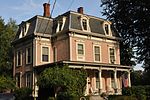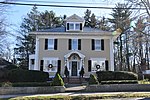Durgin House
1872 establishments in MassachusettsHouses completed in 1872Houses on the National Register of Historic Places in Reading, MassachusettsReading, Massachusetts Registered Historic Place stubs

The Durgin House is a historic house in Reading, Massachusetts. Built in 1872 by Boston businessman William Durgin, this 2+1⁄2-story wood-frame house is one of the finest Italianate houses in the town. It follows a cross-gable plan, with a pair of small side porches and bay windows on the main gable ends. The porches are supported by chamfered posts on pedestals, and feature roof lines with a denticulated cornice and brackets. The main roof line also features paired decorative brackets. There are round-headed windows in the gable ends.The house was listed on the National Register of Historic Places in 1984.
Excerpt from the Wikipedia article Durgin House (License: CC BY-SA 3.0, Authors, Images).Durgin House
King Street,
Geographical coordinates (GPS) Address Nearby Places Show on map
Geographical coordinates (GPS)
| Latitude | Longitude |
|---|---|
| N 42.522222222222 ° | E -71.12 ° |
Address
King Street 84
01867
Massachusetts, United States
Open on Google Maps











